Education assignment on young people activity in social media and potential risks of fake news
Question
Task: You are supposed to explore the concept of fake news amongst teenagers and children using social media platforms, the notion of liberalism, and approaches to managing fake news in your education assignment.
Answer
Introduction
Social media and its impact on the lives of people across the world has been the most discussed and researched topic for education assignments, for over a decade. It is estimated that almost 4.6 billion people across the globe are active users of various social media platforms. 58.4% is the current penetration rate of social media. It has become an integral part of everyone’s life. Social media is known for transforming our process of interaction over a period of time (Dixon, 2022). Understanding the impact of social media platforms on the corporate environment or education sector is critical while writing an education assignment. Marketing practitioners across the world are highly benefitted through this platform. A large number of audiences can be tapped with the help social media campaigns. Furthermore, informative videos on several topics available on Facebook and Instagram help students to gather knowledge. This has increased the usage of several social media platforms of young people. Young people are using several social media platforms not only for gathering information but these platforms also provide entertainment and help young people to build networks globally(Mayo Clinic, 2022). On the contrary, usage of social media platforms has also increased risks and problems in the lives of young people. Circulation of fake news is one of the major disadvantages of social media platforms according to the education assignment. When any misleading information is presented as news and is intended to spread like a wildfire is known as fake news.Fake news is generally fabricated to ruin someone’s reputation or reputation of an entity.A huge section of young people often gets trapped in this fake news and their lives can often get spoilt due to this. Thus, parents have become conscious on their children’s social media usage. This education assignmentaims at analyzing the impact of fake news in the lives of young people and how English system of education can help these young people overcome these challenges.
Background informationin the education assignment
Experiences of young people on social media are a wide topic and it has been explored several times. Young people generally connect with their friends or acquaintances through platforms like Facebook, Instagram and many more as per the findings in the education assignment. Photos, videos and contents are often shared by young people that have a close connection with their personalities. Almost 49% of young people or teens posts about their achievements and accomplishments and 44% of them are vocal about their family background (Anderson and Jiang, 2018). Furthermore, 45% teens in one of the education assignmentsurveys said that they post their selfies on social media platforms sometimes. Various education assignmentsurvey also revealed that posts done by girls are also somewhat different from their male counterparts(Anderson and Jiang, 2018).
Fig 1. Teens post about their daily lives.
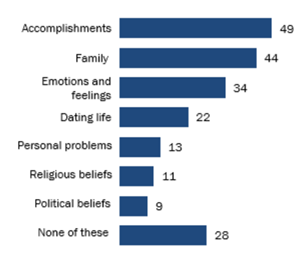
Source: Anderson and Jiang, 2018
Fig 2. Types of posts of young people
On the other hand, parents are currently worried about their children because the usage of social media among young people is constantly increasing. A large number of parents across the world are complaining about the amount of time spent by their children on several social media platforms and how this is affecting their education assignmenteducation, physical and mental health. It has been found that a huge section of young people posts negative comments, trolls’ people and share fake news (Ehmke, 2022). Such negative activities performed by a certain group of people have an impact on other sets of young people. Thus, it can be said that young people perform both positive and negative activities in several social media platforms.
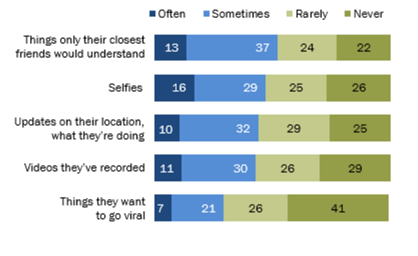
Source: Anderson and Jiang, 2018
Problem statementof the education assignment
Fake news, trolling, extravagant lifestyles are aspects that have an impact on the lifestyle of young people who are also social media users. As mentioned earlier in the education assignment, social media platforms allow visitors to leave comments in several posts. People generally comment their opinions in these platforms. There are various types of comments. Comments that are provocative, offensive and menacing are identified as trolling (de la Vega and Ng, 2018). Trolling often destroy confidence of young people and it can have a negative impact on their personality. Apart from trolling, portrayal of extravagant lifestyle of celebrities and influencers also indirectly impacted the lives of young people.It is found in this education assignment that constant flaunting of wealth by celebrities and other rich people with large number of followers can be sometimes harmful.Young people get attracted towards this materialistic lifestyle. This often increases their expectations of living which further have an impact on their mental health (Carson, 2021). Therefore, this can be marked as another major problem among young people behind usage of social media platforms.
Furthermore, if the current education assignmentis taken into consideration, it can be found that incessant spreading of fake news among social media users is the most dangerous problem and it hugely affects the lives of young people. Mob violence, suicides, FOMO are major impact behind fake news. The constant spread of misinformation is not something new that social media users are encountering according to the education assignment. There are large number of information available online that are not true. People tend to fabricate stories and post it various social media platforms. The objective behind this is to increase number of followers, likes and comments. In last few years, the spread of fake news has increased to such an extent that becomes very difficult for social media users to completely trust any sources. Furthermore, fake news that are spread in various social media platforms mostly contain mis-information, mal-information or dis-information (Saidu, 2021).The spread of such fake news as mentioned in the education assignmenthas a deep impact on the lives of young people who might not be able to segregate correct information and fake information.
Evaluation of activities of young people in various social media platforms
The purchasing behavior of young people are highly influenced by contents that are spread in several social media platforms. In a recent education assignmentsurvey it has been found that 62% of consumers who belong to the age group of 13-39 years are interested in shopping through online platforms(YPulse, 2020).The major reason behind increase in the rate of shopping through social media platforms is the laziness of Gen Z and millennials to visit store and carry out their shopping(Ypuluse, 2020).Moreover, the outbreak of the pandemic and the urge of government to maintain social distancing has also becomeone of the major reasons young people have stopped moving out of their house. The following image in the education assignmentportrays percentage of shopping done by young people via social media platforms.
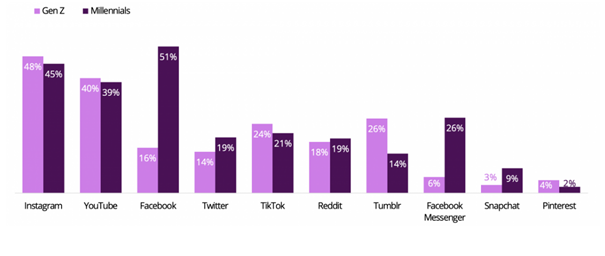
Fig 3. Social media platforms from which young people shop
Source: Ypulse, 2020
Thus, from the above image mentioned in the education assignmentit can be said that shopping is one of the most important activities that young people do via social media platforms.
Apart from shopping young people also read news in the education assignment that is associated with politics and political viewpoints from several social media platforms(Boulianne and Theocharis, 2020).Young people tend toread newsthey find interesting and political news that can have an impact on their lifestyle, education and career. The following image in the education assignmentportrays the proportion of people who belong to the age group 18-24 and read political news through social media platforms.
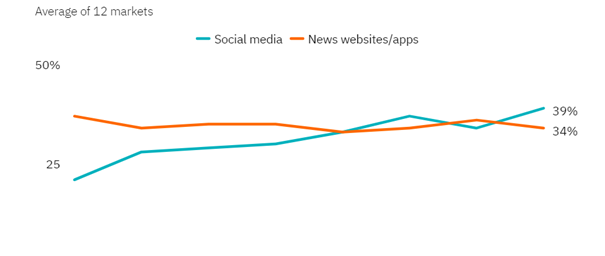
Fig 4. Source of news consumption of people who belong to the age group of 18-24 years
Source: Eddy, 2022
The image in the education assignmentsuggests that 39% of people who belong to this age groupreadpolitical news through social media platforms. Thus, getting insights about political actions and instabilities can be marked as another major activity of young people residing at various parts of the world.
As mentioned earlier in the education assignment, social media platforms are mostly used by young people. Thus, they tend to get most information and news about the world via these platforms. There is no exception in case of Covid-19 news. Young people read news and posts related to Covid-19 through Facebook, Instagram and other such platforms. Evidence-based education assignmentcontent that also have visual appealing tend to have gathered more views and comments from young people. Young people have read such contents because they wanted to keep themselves and their family safe amidst the pandemic.
Critical Analysis
According the Libertarian press theory, news readers and other media houses should have the liberty to report any information and communicate it to the world. Thus, it can be said in theeducation assignmentthat this theory allows press or media houses to focus on marketing a diverse idea and broadcast it without any fear or any kind of suppression. The open discourse theory has also been built on the libertarian theory that further gives media houses liberty to share information openly and transparently (Muller, 2019).Press is also marked as a medium where opinion, arguments and facts should be broadcasted. Contradicting point of view of people from different parts of the world can be airedto the world (Ogbebor, 2020). On the contrary, this theory in the education assignmentalso warns to the media houses that it is not the responsibility of the journalists to act as a watchdog of the society. Instead, they should focus on reporting correct information that can further have a changing impact on the society.
The following image in the education assignmentrepresents number of pages that were flagged by social media users because these pages were accused of sharing false or misleading information.
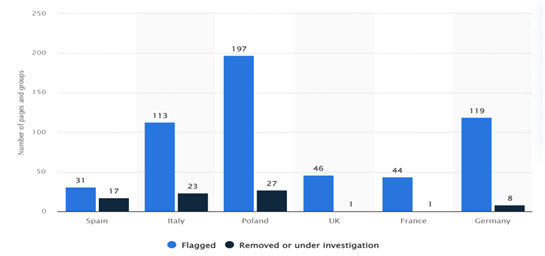
Fig 5. Facebook pages flagged and removed in 2019
Source: Watson, 2021.
Thus, from the above image in the education assignment it can be interpreted that the situation is very serious. Circulation of such fake news have an impact on organizational members, educators, young people and other citizens (Carr, Cuervo Sanchez and Daros, 2020).It mostly exploits children in several ways. Thus, circulation of fake news changed the mindset of young people that also have a negative impact on their purchasing behavior (Talwar, et.al., 2020). This can be stopped with the help of CEOP initiatives. These initiatives mentioned in the education assignmentaim at reducing exploitation of kids and protecting them from online activities (CEOP, 2022).CEOP centres help parents of children below 18 years to report any kind of misleading information that their children are reading in various social media platforms. The objective of these centres is to take initiative and help these children to understand the difference between fake news and real news. Moreover, CEOP initiatives also train parents of young people so that they can keep themselves alert about online activities of their children.
In contrast with the above point of view in the education assignment, a survey has been published on behalf of the Standford university(Haut, 2017). The survey suggested that there are many young people who hardly have the ability to discriminate fake news and correct news. In such cases, PSHE education is of utmost importance. Spotting fake news is an integral part of PSHE education. As per this education system young people are asked to read a news headline and they are also asked whether the story is fake or real. Young people or students are asked to vote on the basis of their “gut instincts”. Once, the voting is done they are taught how one can identify a fake news. A fake news will not have limited information, instead it will report the entire event that took place. The feeling of an individual after reading the story can also help them identify whether the news is fake or real. Real news always aims at alerting students whereas the intention of fake news is to demotivate and break the confidence of young people(The Guardian Foundation, 2022).Thus, the education assignmentsurvey concludes that young people who have not yet built ability to segregate correct information from incorrect information might also be a threat to democracy (Haut, 2017). This can be reduced with the help of PSHE education system.Furthermore, usage of ICT can also help in raising awareness among people across the world. This can further help young people to start critical thinking before sharing any kind of news.
Furthermore in the education assignment, mis-information that is related to the vaccination of Covid-19 has been one of the major components of fake news (Howard, Neudert and Prakash, 2021). Health-care centres, doctors and other stakeholders of the healthcare industry repeatedly requested people across the world to take their vaccines as early as possible but interruption of misleading information in various social media platforms created a major issue. Young people were severely affected by these mis-information. This can be reduced with the help of digital literacy technique. Digital literacy is helping people improve their professional and personal lives more effectively in the 21st century (Tejedor, et.al., 2020).Digital literacy helps young people to think critically. Young people should understand the positive and negative aspects of a news. This can further help them to analyse any fake news of vaccination while writing education assignment. Digital literacy also has the power to empower young children by enhancing their knowledge and attitudes towards news that are fake and is constantly circulated in several social media platforms. This is how digital literacy can prevent young people from consuming news that are misleading and harmful.
Recommendations
The following section of the education assignmentemphasizes on recommending actions that young people might undertake in order to avoid fake news and its impact on their lifestyle.
• It is highly recommended in the education assignmentto the younger generation of the world to google each and every information they read before trusting the news. Proper research can help them understand whether the news they have seen is a fact or a misleading information(Fazio, 2020).This can further prevent them from consuming toxic or harmful news.
• It is recommended in the education assignmentto the younger generation to believe in the concept “think before share”. This means one should not share any content that contains fabricated news or misleading information (Apuke and Omar, 2021). This will not only have an impact on their lives but other people will also be affected with such news or misleading information. Thus, contents that 100% true should only be shared by young people so that other people can read the correct news.
• It is recommended in the education assignmentto the younger population to read contents that are related to Covid-19 and other diseases only from government websites or websites like WHO and UNICEF.These websites contain credible information and website credibility helps people to get correct information (Keshavarz and Givi, 2020). This practice will not only help young people to avoid fabricated news but it will also help them to get reliable information about the disease and improve their health conditions.
• Parents should enhance their knowledge about social media platforms (Harmoko, 2021). They should know how things happen in these platforms. Furthermore, they are highly recommended to follow their children. Constant monitoring of their children’s activities can help young people to avoid misleading information.
Conclusion
The education assignmentaimed at analysing the impact of fake news on the lives of young people and how English system of education can help young people differentiate between fake and real news. The findings of the education assignmentconclude that the usage of various social media platforms among young people is more than that of people above 35 years. Young people tend to consume each and every content posted on social media platforms like Facebook and Instagram on a regular basis. Consumption of contents by young people have both positive and negative impact on the lives of these young people. Gen Z and millennials are considered to be smarter than Gen X because they tend to read information more tactically. Social media platforms have helped them to get an overview of the entire world quickly and more conveniently while writing the education assignment. Despite this, the mental health condition of young people is often getting degraded because of increased consumption of fake news. Fake news or misleading information is guiding the young generation in a wrong path. Thus, PSHE education, CEOP initiatives and digital literacy can help these young people to overcome their challenges. The objective of these initiatives mentioned in the education assignmentis to enhance the knowledge of fake news and create awareness among young people and their parents. Stakeholders of these initiatives believe that a proper system of education can help young people to prevent themselves from consuming fake news.
Reference List
Anderson M. and Jiang, J. 2018. Teens and their experiences on social media. [online]. Available at https://www.pewresearch.org/internet/2018/11/28/teens-and-their-experiences-on-social-media/ (Accessed 03 August 2022).
Apuke, O.D. and Omar, B., 2021. Fake news and COVID-19: modelling the predictors of fake news sharing among social media users. Telematics and Informatics, 56, p.101475.
Boulianne, S. and Theocharis, Y., 2020. Young people, digital media, and engagement: A meta-analysis of research. Social Science Computer Review, 38(2), pp.111-127.
Carr, P.R., Cuervo Sanchez, S.L. and Daros, M.A., 2020. Citizen engagement in the contemporary era of fake news: hegemonic distraction or control of the social media context. Postdigital Science and Education, 2(1), pp.39-60.
Carson, E. 2021. Showing off wealth on social media? Get ready for the backlash. [online]. Available at https://www.cnet.com/culture/showing-off-wealth-on-social-media-get-ready-for-the-backlash/ (Accessed 03 August 2022).
CEOP, 2022. Are you worried about online sexual abuse or the way someone has been communicating with you online? [online]. Available at https://www.ceop.police.uk/Safety-Centre/ (Accessed 10 August 2022).
de la Vega, L.G.M. and Ng, V., 2018, May. Modeling trolling in social media conversations. In Proceedings of the Eleventh International Conference on Language Resources and Evaluation (LREC 2018).
Dixon, S. 2022. Social media - Statistics & Facts. [online]. Available at https://www.statista.com/topics/1164/social-networks/#dossierKeyfigures (Accessed 03 August 2022).
Eddy, K. 2022. The changing news habits and attitudes of younger audiences. [online]. Available at https://reutersinstitute.politics.ox.ac.uk/digital-news-report/2022/young-audiences-news-media (Accessed 03 August 2022).
Ehmke, R. 2022. How Using Social Media Affects Teenagers. [online]. Available at https://childmind.org/article/how-using-social-media-affects-teenagers/ (Accessed 03 August 2022).
Fazio, L., 2020. Pausing to consider why a headline is true or false can help reduce the sharing of false news. Harvard Kennedy School Misinformation Review, 1(2).
Harmoko, D.D., 2021. Digital Literacy As A Solution To Improve The Quality Of Indonesia's Human Resources. Research and Development Journal of Education, 7(2), pp.413-423.
Haut, S. 2017. Students lack awareness of fake news. [online]. Available at https://theithacan.org/news/students-lack-awareness-of-fake-news/ (Accessed 03 August 2022).
Howard, P. N. Neudert L.M. and Prakash, N. 2021. Digital misinformation / disinformation and children. [pdf]. Available at https://www.unicef.org/globalinsight/media/2096/file/UNICEF-Global-Insight-Digital-Mis-Disinformation-and-Children-2021.pdf (Accessed 03 August 2022).
Keshavarz, H. and Givi, M.E., 2020. A scale for credibility evaluation of scientific websites: findings from a cross-contextual approach. Online Information Review.
Mayo Clinic, 2022. Tween and Teen Health. [online]. Available at https://www.mayoclinic.org/healthy-lifestyle/tween-and-teen-health/in-depth/teens-and-social-media-use/art-20474437#:~:text=Social%20media%20is%20a%20big,%2C%20Facebook%2C%20Instagram%20or%20Snapchat. (Accessed 03 August 2022).
Muller, D., 2019. Open discourse: A media theory for the twenty-first century. Ethical Space, 16(1), pp.3-10.
Ogbebor, B., 2020. Media Policy, Democracy and Theories of the Press. In British Media Coverage of the Press Reform Debate (pp. 53-75). Palgrave Macmillan, Cham.
Saidu, D., 2021. Mis, Dis, and Mal-Information through Social Media during the Covid 19 Pandemic: A case study of Nigeria. Academia Letters, p.2.
Talwar, S., Dhir, A., Singh, D., Virk, G.S. and Salo, J., 2020. Sharing of fake news on social media: Application of the honeycomb framework and the third-person effect hypothesis. Journal of Retailing and Consumer Services, 57, p.102197.
Tejedor, S., Cervi, L., Pérez-Escoda, A. and Jumbo, F.T., 2020. Digital literacy and higher education during COVID-19 lockdown: Spain, Italy, and Ecuador. Publications, 8(4), p.48.
The guardian Foundation, 2022. Lesson 5 Spotting fake news (PSHE education). [online]. Available at https://theguardianfoundation.org/programmes/newswise/schools/unit-of-work/lesson-5-spotting-fake-news-pshe-education (Accessed 07 August 2022).
Watson, A. 2021. Number of Facebook pages and groups removed, following investigations into fake news in Europe in 2019, by country. [online]. Available at https://www.statista.com/statistics/1077107/fake-news-facebook-pages-removed-in-europe/ (Accessed 03 August 2022).
YPulse, 2020. The Social Platforms Gen Z & Millennials Are Open To Shopping On, In One Chart. [online]. Available at https://www.ypulse.com/article/2020/10/19/the-social-platforms-gen-z-millennials-are-open-to-shopping-on-in-one-chart/ (Accessed 03 August 2022).












